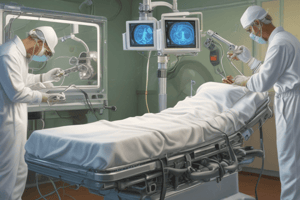Podcast
Questions and Answers
What is the main function of the console in a robotic surgery system?
What is the main function of the console in a robotic surgery system?
- To provide a clear and magnified view of the operating site
- To hold the surgical instruments and camera
- The surgeon's control station where they sit and manipulate the robotic instruments (correct)
- To assist the surgeon during the procedure
What is the advantage of robotic surgery in terms of tissue damage?
What is the advantage of robotic surgery in terms of tissue damage?
- Increased precision and dexterity
- Reduced blood loss
- Less tissue damage and smaller incisions (correct)
- Improved visualization
What type of robotic surgery is used for procedures such as lung resection and esophagectomy?
What type of robotic surgery is used for procedures such as lung resection and esophagectomy?
- General robotic surgery
- Thoracoscopic robotic surgery (correct)
- Urologic robotic surgery
- Laparoscopic robotic surgery
What is the function of the high-definition 3D camera in a robotic surgery system?
What is the function of the high-definition 3D camera in a robotic surgery system?
What is the advantage of robotic surgery in terms of blood loss?
What is the advantage of robotic surgery in terms of blood loss?
Flashcards are hidden until you start studying
Study Notes
Robotic Surgery
Definition Robotic surgery, also known as robot-assisted surgery, is a type of minimally invasive surgery that uses a robotic system to assist the surgeon during the procedure.
Components of a Robotic Surgery System
- Console: The surgeon's control station where they sit and manipulate the robotic instruments.
- Patient-side cart: The robotic arms that hold the surgical instruments and camera.
- Surgical instruments: Designed to mimic the movement of the human hand, with enhanced dexterity and precision.
- High-definition 3D camera: Provides a clear and magnified view of the operating site.
Advantages
- Enhanced precision and dexterity: The robotic system allows for more precise dissection and suturing.
- Improved visualization: The high-definition 3D camera provides a clear and magnified view of the operating site.
- Less invasive: Smaller incisions and less tissue damage result in less pain and scarring for the patient.
- Reduced blood loss: The robotic system allows for more precise control of bleeding.
Types of Robotic Surgery
- Laparoscopic robotic surgery: Used for procedures such as cholecystectomy, hysterectomy, and prostatectomy.
- Thoracoscopic robotic surgery: Used for procedures such as lung resection and esophagectomy.
- Urologic robotic surgery: Used for procedures such as prostatectomy and kidney surgery.
Robotic Surgery in Specific Specialties
- Urology: Prostatectomy, kidney surgery, and bladder surgery.
- Gynecology: Hysterectomy, endometriosis treatment, and tubal ligation.
- Cardiothoracic surgery: Heart bypass surgery, heart valve repair, and lung resection.
- General surgery: Cholecystectomy, hernia repair, and colon resection.
Challenges and Limitations
- Cost: The high cost of the robotic system and maintenance.
- Training and experience: Surgeons require specialized training and experience to operate the robotic system.
- Technical difficulties: The risk of technical difficulties and robotic system failures during surgery.
Studying That Suits You
Use AI to generate personalized quizzes and flashcards to suit your learning preferences.





